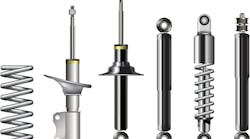We’ve come a long way since Henry Ford first declared “You can have any color, so long as it’s black.” Nowadays, we expect nothing less than the ability to customize everything from our TV schedule to our mobile phones; personalization and customization are king and springs are no exception.
The range of functions that springs can perform within different industries makes them the perfect example of how materials can be manipulated in order to perform multiple applications. However, it wasn’t always that way.
To understand how springs can now be customized for a range of projects, it’s important to look at how advanced they have become since their beginnings, as well as gaze toward the future to analyze certain expectations.
Springs Past
Since the humble beginnings of Bronze Age, non-coil springs such as eyebrow tweezers have gone through a number of progressions that have guided us to today. However, we still use the same technology that was discovered all those years ago, albeit in a more advanced form. For instance, during the third century B.C., it’s believed that combinations of leaf springs were used by Ctesibius of Alexandria to operate a catapult. Although it wasn’t powerful enough to be a success, we do still use leaf springs in the modern day, most notably as part of the suspension in wheeled vehicles.
As technology and the understanding of how springs work expanded, their complexity and modes of operation catered to more industries. The biggest step was the creation of the coiled spring, believed to have been first developed and used in the early 15th century, allowing for clocks to become portable. Prior to this innovation, weights were used to power time-telling machinery. However, despite this leap in spring technology, these “portable” clocks were in fact three or more inches in diameter, thick, and generally made of iron or steel, making them unsuitable as wristwatches for another four centuries.1
Springs Present
Thanks to the Industrial Revolution, springs began being mass-produced around the turn of the 19th century, allowing for quick and innovative advancement. An improvement in the production of steel meant that it could be made relatively cheaply compared to the previous cost, allowing spring usage to expand at a rapid pace.
In even more recent times, the rise of CAD has allowed for custom-made creations, expanding the market even further and cutting down on time, energy, and waste. The same CAD software that can be used to design springs big enough to support entire buildings through an earthquake can also create 30-micrometer-sized versions for medical use. Spring’s versatility suggests that the manufacture and use of spring technology isn’t going to slow down anytime soon.
CAD systems allow springs to be mass-produced in an array of sizes and shapes to pinpoint precision, bypassing human error that came before the systems. These mathematical models are based on the understanding of Hooke’s Law. Engineering springs for specific uses wouldn’t be possible, nor would we be able to enhance performance without this law.
CAD simplifies the design process by measuring whether different components slot together without the lengthy process of trial and error once they’re printed, as well as letting you easily alter already existing designs. CAD also allows for variable factors, e.g., wire composition, coil diameter, and the amount of external force, to be changed and calculated automatically. From this understanding, designers are able to determine if the cost and time of the final design is suitable for manufacturing.
New discoveries, such as how heat treatment strengthens certain ferrous metals and alloys after being coiled, allow numerous industries to expand the applications for springs. Also, in appropriate steels, new discoveries provided higher ductility and resistance to hydrogen and environmental embrittlement (to name but a few benefits). Similarly, developments in cast irons enabled low distortion and a repeatable dimensional response.
These discoveries have allowed for the wide range of springs that are made and used on a daily basis. But our ever-expanding understanding of new materials and technologies means that the springs of tomorrow could look and perform completely differently than what’s presently available.
Springs Future
Even after the evolution of over thousands of years, the future of spring technology could be completely different to what it is today. Over the past few decades, demand for minuscule coils has increased because of their uses in phones, touchpads, and other electronic devices. So it’s likely that the technology of tomorrow will require a different kind of spring in some shape or form in order to function.
The next stage of spring manufacturing and engineering itself looks as though it could involve 4D printing and 2D materials. The former, currently being researched by the Massachusetts Institute of Technology, may offer a way to create objects that transform over time or self-assemble.
The latter concerns materials that are one or a couple atoms thick. Coined 2D materials, they are showing interesting material properties. Production methods for 2D materials are currently being developed to reduce cost and produce larger volumes. Advances made in processing these materials could pave the way for an even wider range of uses for springs.
For instance, the carbon crystalline allotrope, such as in the 2D-material graphene, is hundreds of times stronger than most steels by weight, and has demonstrated a large elongation of up to 480% with a stable elasticity coefficient for 100,000 times of stretch. Furthermore, under electrostatic effects, the stretchable actuation force of graphene is reversible.2
Research into the use of graphene fiber springs is still underway, but it shows great potential for the future of spring technology.
Martyn Tyndall has worked in the spring manufacturing sector for a number of years, arranging and liaising with a number of industries in order to create bespoke springs.
